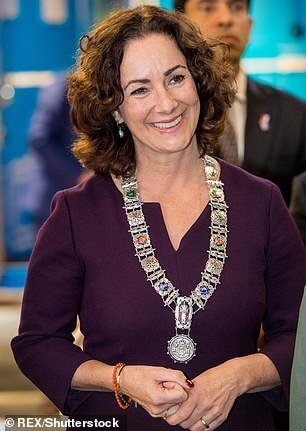The end of Amsterdam’s glass brothels? Dutch capital’s first female mayor reviews notorious Red Light district where 370 windows display scantily-clad women
- Amsterdam’s Red Light district founded in 1300s and is the oldest part of the city
- But Femke Halsema, city’s first female mayor, says it could soon be broken up
- She wants tourists to ‘see the cultural value’ in the area, rather than sex shops
- Plan would also spread visitors more evenly across Amsterdam, she explained
Amsterdam’s historic Red Light district could soon be broken up to make way for more ‘cultural’ attractions, the city’s first female mayor has said.
Femke Halsema, 52, said the Wallen district is full of ‘vulnerable foreign women’ being ‘booed by hordes of drunken tourists’ as she vowed to reform it.
Her plans would not get rid of prostitution and sex shops altogether, but would spread them out across the city rather than concentrating them in one area.

That would free up more space for cultural attractions in the oldest and most historic part of the city, she added.
She told Bloomberg: ‘Our inner city is one of the oldest in Europe with an enormous culture historical significance, which is obviously deteriorating.
‘We would like tourists to see the cultural value.’
Amsterdam, which has a permanent population of 850,000, receives some 18million visitors every year, many of whom head straight for the Red Light district.
‘We need to think about what kind of tourists we want to attract,’ she said, ‘and we shouldn’t have any illusion that the number of tourists in the city will go down.
‘It will keep on rising.’
However, she insisted that prostitution and sex shops are here to stay, as she is committed to maintaining the reputation for tolerance.

‘At times Amsterdam has been called too open,’ Halsema said. ‘I think we should currently worry more about whether we are open enough.’
The Rossebuurt – or Red Light district – has existed since the 1300s when it sprung up close to Amsterdam’s harbour.
The district was filled with immigrant women who turned to prostitution after arriving on ships with no money, and on sailors coming ashore after months at sea with pay in their pockets.
Today, women are banned from plying their trade on the street and instead stand in windows illuminated by red lights to advertise themselves.
There are more than 370 windows in the Red Light district, which is one of three areas where prostitutes are allowed to work, though is by far the most famous.
In 2014, it was calculated that Amsterdam’s sex shops and coffeeshops – where marijuana is sold – contributed 2.5billion euros to the economy.




